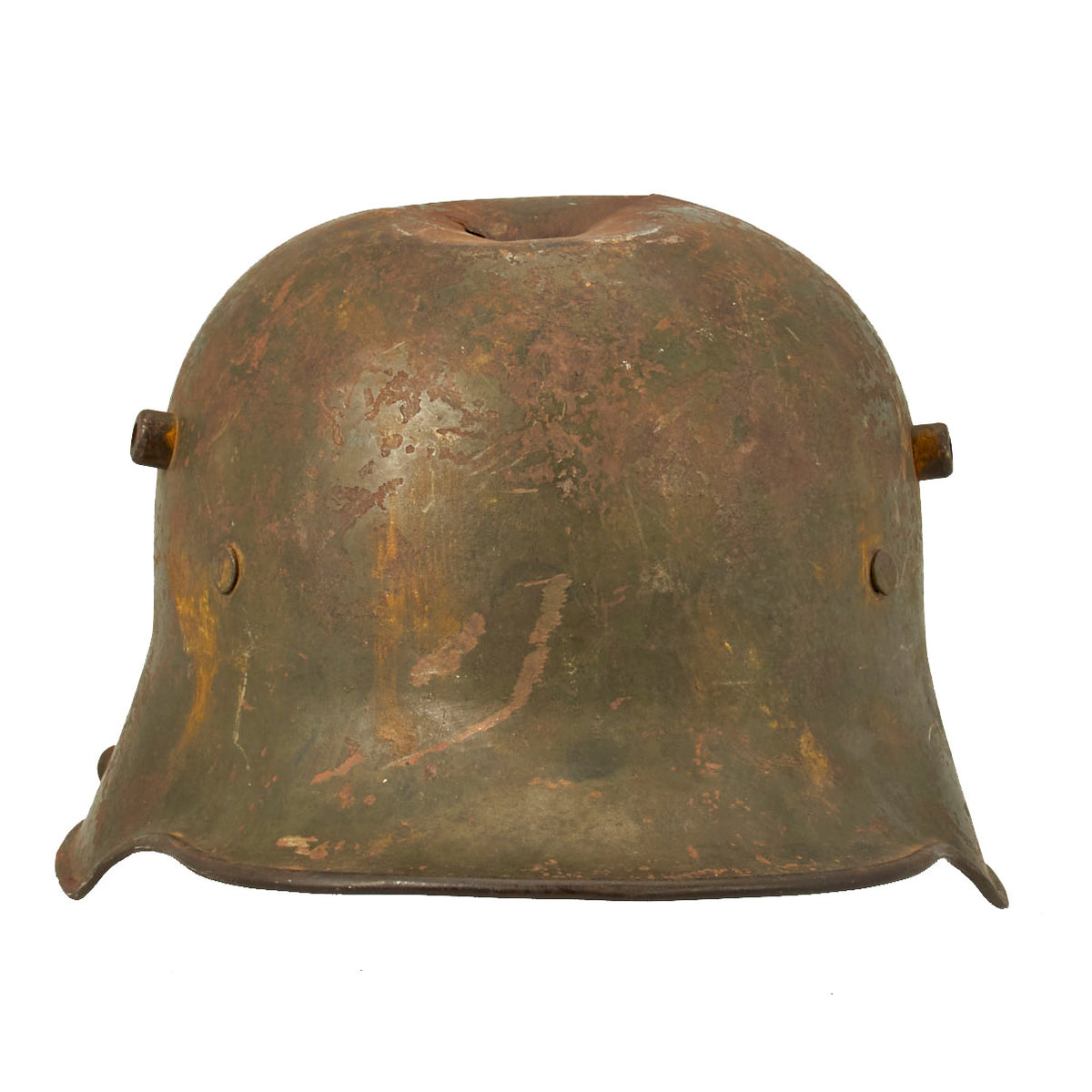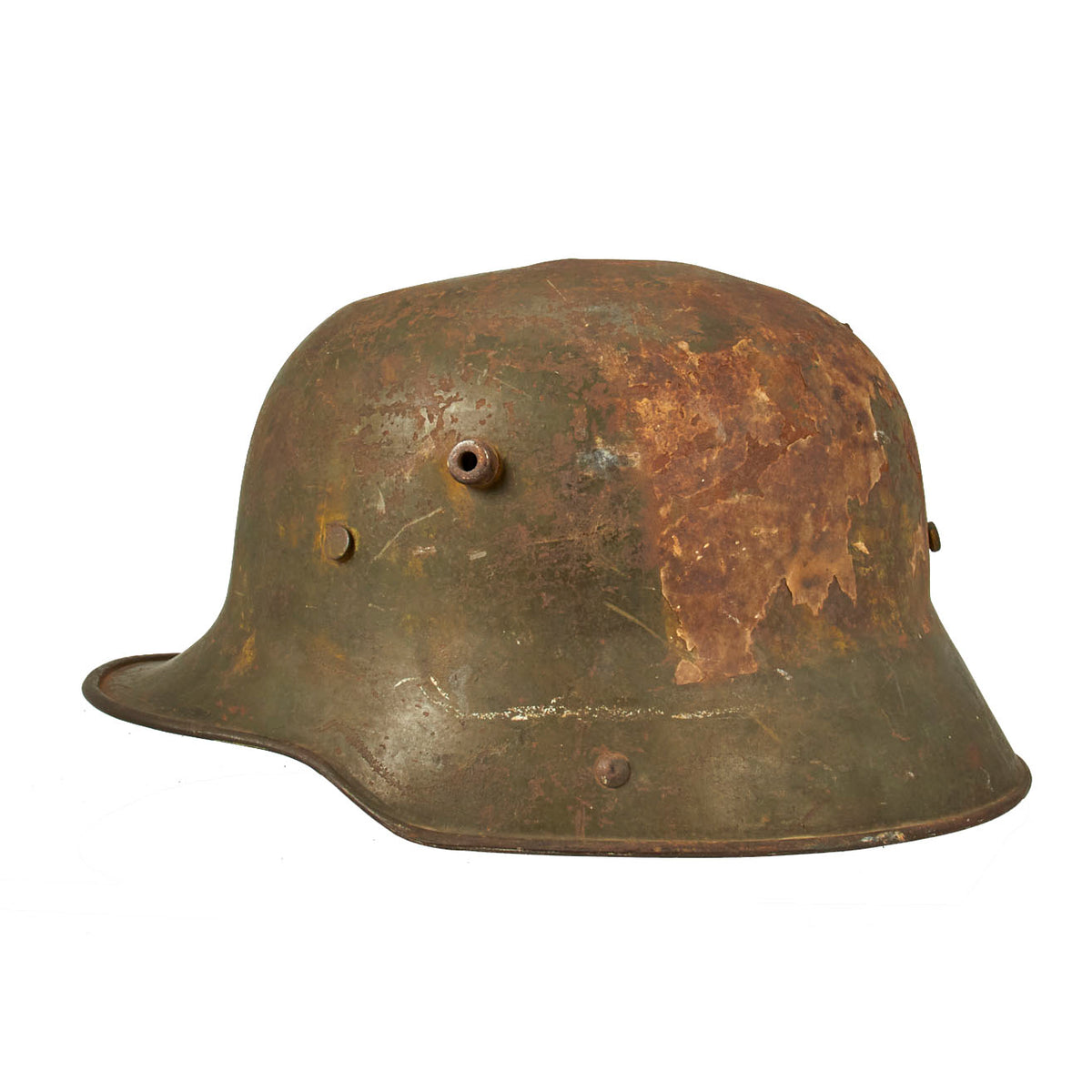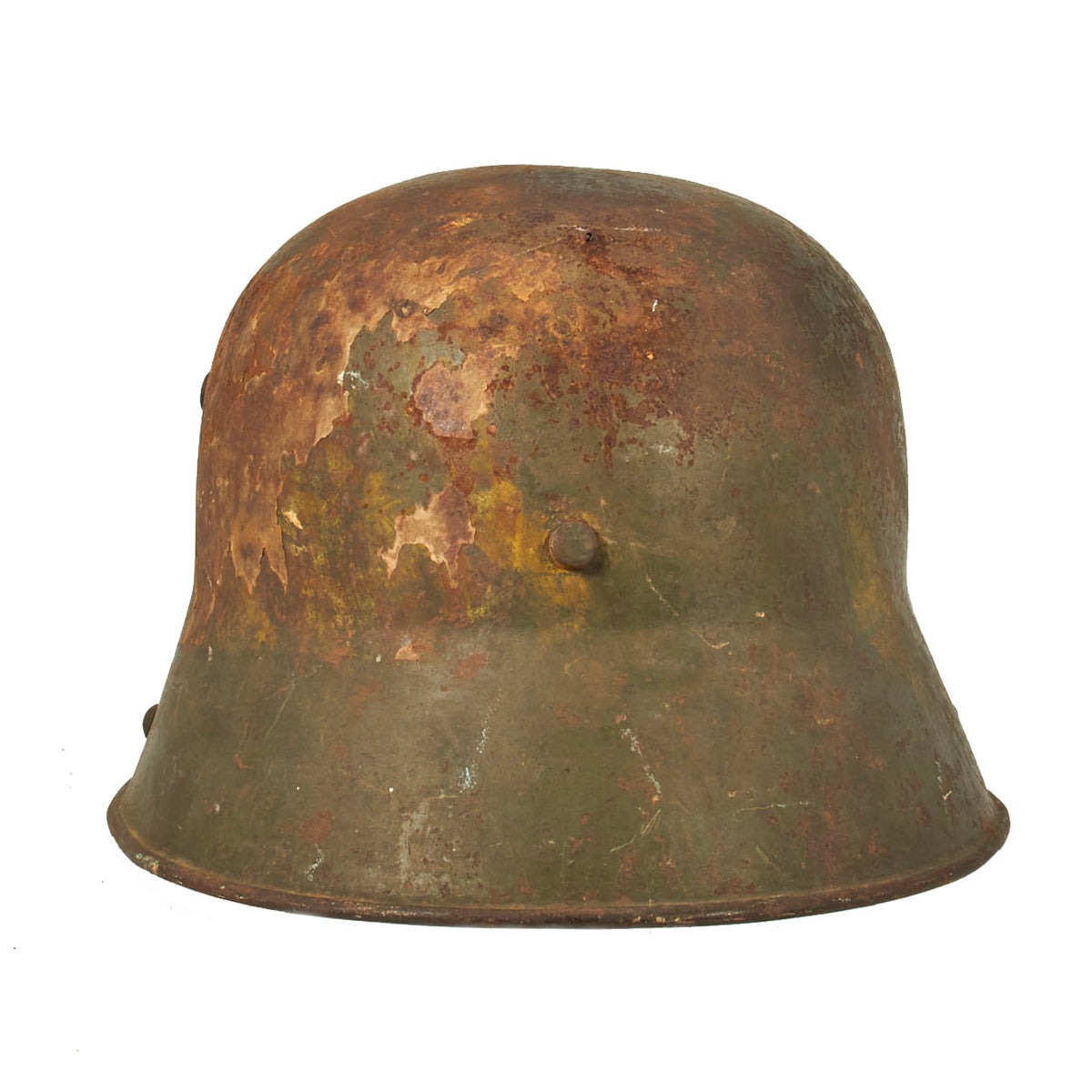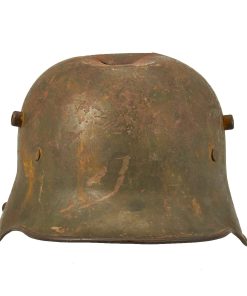Original German WWI Battle Damaged M16 Stahlhelm Helmet with Camouflage Paint and Liner – marked Si66 Original Items
$ 895,00 $ 223,75
Original Item: Only One Available. This is a very nice example of a totally original WWI German M16 Helmet, with a very nice “splotching” camouflage paint scheme. This was a very popular type of camouflage used on both sides of WWI. The most noticeable feature is the impact hole located on the top of the helmet, a solid example on the harsh reality that is warfare.
The stamped, sheet steel construction, helmet retains about 60% of its original green paint. The entirety of the helmet was not painted camouflage, but other colors were just brushed on in areas. The colors that we can see that were used was a mixture of shades of yellow, greens and possibly orange. This was painted over the original field green paint, so this is visible in areas where the paint has flaked off.
The helmet still has both the dome headed chinstrap retaining rivets, which hold the interior pickelhaube style chin strap lugs in place. It also retains both of the extended ventilation side lugs, which are the correct short version without a step for the larger size 66 shell. This would ensure proper installation of a Stirnpanzer brow plate regardless of shell size.
All three liner split pins, including the correct larger rear pin, are present, and still retain most of the camouflage paint. They hold in place the early pattern all leather Liner, which has unfortunately degraded quite a bit, as shown in the pictures. One of the three large “panels” is partially torn, as are the fingers. The chin strap is also missing, as are the attachment loops. It would appear as if any contaminated leather and material was removed when the American soldier shipped the helmet back home. The original shipping label is partially present, but unfortunately is not able to be read properly enough for identification purposes.
The hole at the top is a gruesome looking one made from a larger caliber round, if it was a round that struck the soldier. We hope that this was a battlefield pickup and it was caught up in an exchange of fire while not being worn.
The shell is stamped Si66 indicating that Eisenhuette Silesia in Paruschowitz Oberschlesien manufactured it. This company made shells in sizes 62 and 66 for the war effort. Size 66 is a nice large size that can accommodate liners from 58cm to 60cm or US 7 1/4 to 7 1/2. Size 66 shells are always hard to find and are therefore more valuable to a collector.
This helmet, offered in a highly collectible condition, makes an eye catching and affordable addition to any Great War collection. Ready to display!
History of the M16
The Stahlhelm was introduced into regular service during the Verdun campaign in early 1916.
The M1916 design had side-mounted horn-like ventilator lugs which were intended to be support for an additional steel brow plate or Stirnpanzer, which only ever saw limited use by snipers and trench raiding parties, as it was too heavy for general use.
The shell came in different sizes, from 60 to 68, with some size 70s reported. The suspension, or liner, consisted of a headband with three segmented leather pouches, each holding padding materials, and leather or fabric cords could be adjusted to provide a comfortable fit. The one-piece leather chinstrap was attached to the shell by M1891 chinstrap lugs, the same kind used in the Pickelhaube helmet.
The M1916 design provided excellent protection: Reserve Lieutenant Walter Schulze of 8th Company Reserve Infantry Regiment 76 described his combat introduction to the helmet on the Somme, 29 July 1916:
“… suddenly, with a great clanging thud, I was hit on the forehead and knocked flying onto the floor of the trench… a shrapnel bullet had hit my helmet with great violence, without piercing it, but sufficiently hard to dent it. If I had, as had been usual up until a few days previously, been wearing a cap, then the Regiment would have had one more man killed.”
But the helmet was not without its flaws. The ventilator horns often let cold air in during the winter, requiring the wearer to block the vents with mud or fabric. The large, flared skirt tended to make it difficult for soldiers to hear, distorting surrounding sounds and creating an echo when the wearer spoke.
Originally painted Feldgrau (field grey), the Stahlhelm was often camouflaged by troops in the field using mud, foliage, cloth covers, and paint. Official issue cloth covers in white and grey appeared in late 1916 and early 1917. Camouflage paint was not formally introduced until July 1918, when German Army Order II, No 91 366, signed by General Erich Ludendorff on 7 July 1918, outlined official standards for helmet camouflage. The order stipulated that helmets should be painted in several colors, separated by a finger-wide black line. The colors should be relevant to the season, such as using green, brown and ocher in summer.
After the effectiveness of the M1916 design was validated during the 1916 campaigns, incremental improvements were subsequently made.
Fast Shipping with Professional Packaging
Thanks to our longstanding association with UPS FedEx DHL, and other major international carriers, we are able to provide a range of shipping options. Our warehouse staff is expertly trained and will wrap your products according to our exact and precise specifications. Prior to shipping, your goods will be thoroughly examined and securely secured. We ship to thousands clients each day across multiple countries. This shows how we're dedicated to be the largest retailer on the internet. Warehouses and distribution centres can be located throughout Europe as well as the USA.
Note: Orders with more than one item will be assigned a processing date depending on the item.
Before shipping before shipping, we'll conduct a thorough inspection of the items you have ordered. Today, the majority of orders will be delivered within 48 hours. The delivery time will be between 3-7 days.
Returns
The stock is dynamic and we cannot completely manage it because multiple stakeholders are involved, including our factory and warehouse. So the actual stock may alter at any time. It's possible that you may not receive your order once the order has been made.
Our policy is valid for a period of 30 days. If you don't receive the product within 30 days, we are not able to issue a refund or an exchange.
You can only return an item if it is unused and in the same state as the day you received it. You must have the item in its original packaging.
Related products
Uncategorized
Uncategorized
Uncategorized
Uncategorized
Australian WWII Owen MK1 Machine Carbine SMG Custom Fabricated Replica with Sling Original Items
Uncategorized
Uncategorized
Armored Burgonet Helmet & Polearm from Scottish Castle Leith Hall Circa 1700 Original Items
Uncategorized
Uncategorized
Uncategorized
Uncategorized
Uncategorized
Uncategorized
Uncategorized
Uncategorized
Uncategorized
Uncategorized
Uncategorized
Uncategorized













































































